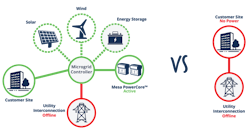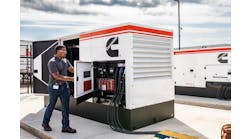Problem #1: Low power generation from utility grid
Historically, when a utility system became capacity “constrained,” the solution was to build bigger central station generators. These installations were difficult to build in the past and are even more so now. This is partly because of the risk of recovering such large investments in a constantly changing regulatory environment and partly because of the difficulty of producing a large enough solution that meets a wide variety of environmental and emissions goals. By contrast, it is much easier to install multiple, smaller sources of power generation throughout the utility distribution system. Microgrids, which can have just a few or several different types of resources, will provide the utility with the aggregate amount of system capacity required as well as potentially supporting other electrical parameters such as voltage and frequency stability. And these distributed projects can be staged over time as capacity requirements rise, thus avoiding the financial step increase hurdles of large generation stations.
Problem #2: Unreliable grid power
Everyone wants reliability. There are a number of things that utilities are doing to make their overall delivery systems more reliable. “Make the grid smarter” is often the banner for such improvements. But while these efforts probably do make the system uptime better, they don’t eliminate outage risk completely. In other words, a new technology that effectively makes a transmission line segment less likely to “trip out” doesn’t stop a car from hitting a pole just outside the substation that feeds a 10- to 20-mile-long distribution circuit. However, by taking advantage of distributed generation for capacity as described above, utilities could strategically place that generation in ways that keep most customers on for the most amount of time. Smaller neighborhood or district microgrids would keep the power on for their respective areas by providing distribution circuits that are segmented into strings of microgrids, thus enabling the isolation of the segment with operational issues while keeping the other segments energized.
Problem #3: Utility grid lacks resilience
Finally, real reliability means that a customer can keep operating even while those around them are out. We’ve come to call it “resilience” — having a Plan B for when Plan A fails, and it will fail. Customers can make decisions about the resilience they need. “How many hours/days do I need to be able to operate independent of the grid?” “How much do I want to try to rely on renewables during that time period?” More and more, utilities are implementing programs that help provide this type of resilience for their customers. Some utilities in deregulated markets are deploying resilient systems on customers’ premises. If the grid goes out, the customer has the standby system. If the grid is up and the utility can take advantage of market opportunities by bringing on the standby system, it may do so. Even in regulated markets, some utilities are helping their customers finance backup systems over long periods of time.
Conclusion
In the 1980s, early in my career at an electric utility, we had an incident of a single customer outage in a very rural area at the end of a long distribution circuit. To notify us of the outage, the customer mailed us a postcard. This is unheard of in today’s fast-paced environment when customers demand large amounts of power, and they want it all the time. An energy executive recently observed that the gap between the reliability that customers want and the reliability that utilities can provide is continuing to widen. For those embracing traditional solutions, this statement will remain true. But for those wanting to leverage opportunities using distributed generation and microgrids, facilitated by companies like Mesa Solutions, that gap can start to close, and the utility gets to be the hero.
Tom Poteet is vice president of corporate development at Mesa Solutions.









